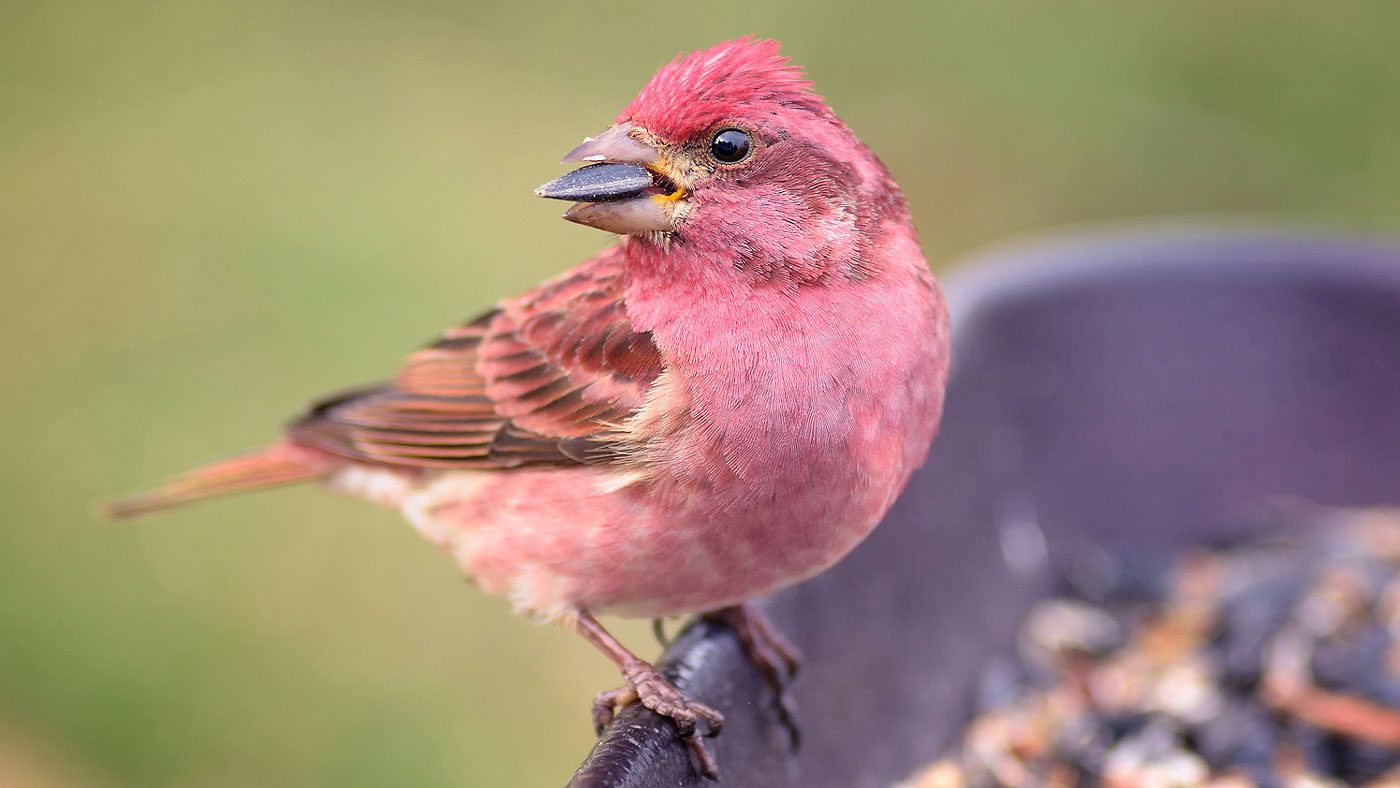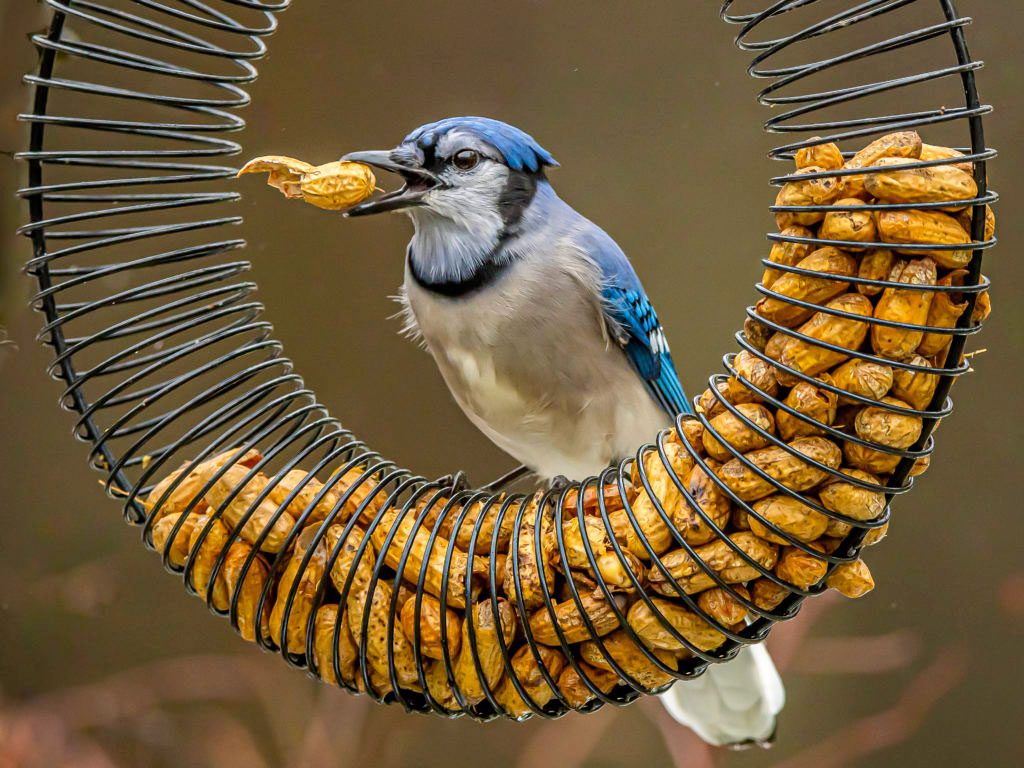
Originally published April 2009; most recent update August 2024.
Putting up bird feeders in a yard or outdoor space is a great first step to brightening up the view from your window. A well-tended set of feeders can attract throngs of regular visitors, and may also host unusual birds that visit with the seasons, such as Pine Siskins, Redpolls, Evening Grosbeaks, and more.
But there’s a tremendous variety of bird feeders to choose from—so where do you start? It helps to recognize that most seed feeders are variations on just a few basic designs: trays, hoppers, tubes, window mounts, and suet feeders.
To attract the greatest variety of birds, provide several different feeder types and offer a variety of foods. It’s best to start out with black-oil sunflower seed; it’s the most widely used seed, and it attracts the largest range of species. Hanging a tube feeder from a tree branch or shepherd’s crook is an easy way to get started—just be sure to use a squirrel baffle if you don’t want squirrels crashing the party.
Once you’ve chosen a feeder type, selecting a specific model comes down to construction, squirrel-proofing, and of course aesthetics. The ideal bird feeder is sturdy enough to withstand winter weather and squirrels, tight enough to keep seeds dry, easy to assemble and, most important of all, easy to keep clean.
Tray or Platform Feeders
In Brief: Platform feeders attract the widest variety of seed-eating feeder birds, although they are the most susceptible to raids by squirrels and other possibly unwanted guests.
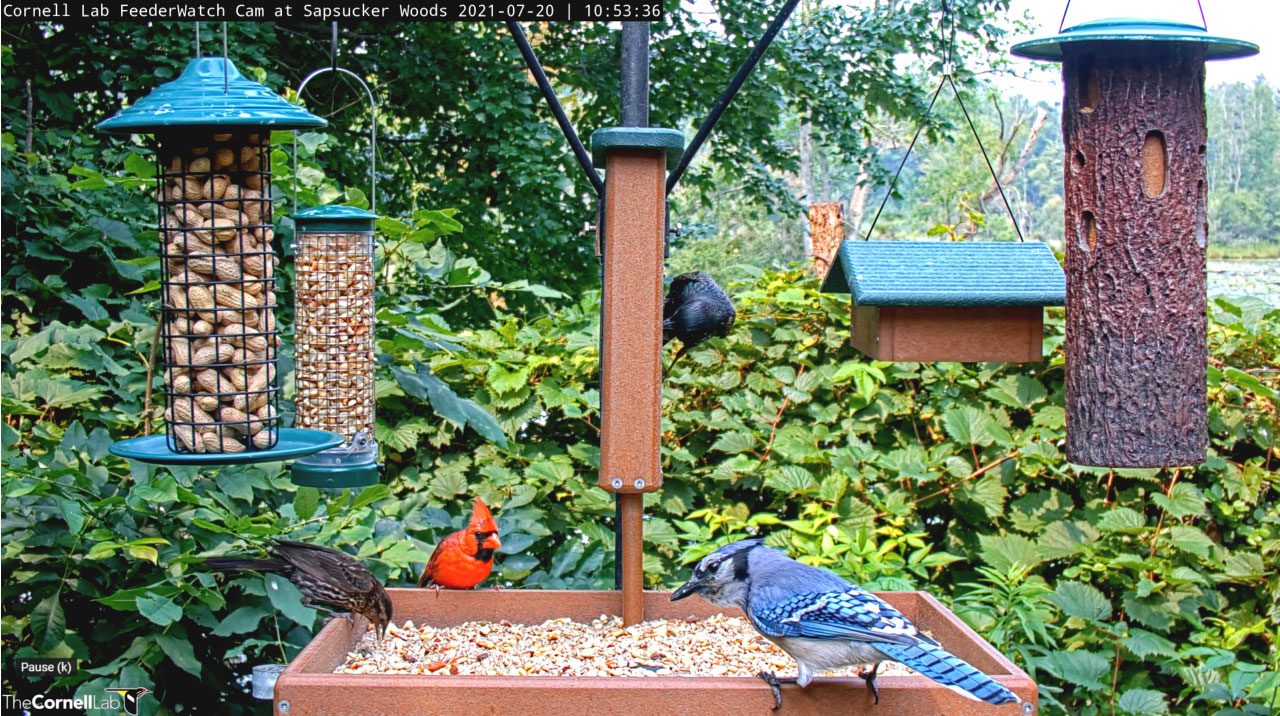

Pros:
- Good for attracting grosbeaks, sparrows, juncos, towhees, jays, blackbirds, doves, quail, and more
- With no structure to block sight lines, the birds remain in full view while feeding
- Can offer lots of seed over a wide area, allowing many birds to visit at once
- Versatile: can be mounted on deck railings, posts, stumps, or can be suspended
Cons:
- Attracts birds such as pigeons, starlings, House Sparrows, and grackles, which can sometimes overwhelm other species
- Doesn’t protect against rain or snow; seeds can get wet and sprout, mold, or spoil
- Bird droppings can quickly soil the seeds
- Can invite squirrels, chipmunks, deer, raccoons, and more
Tips:
- Look for a tray with a screened rather than solid bottom for better drainage
- Offer enough seed for a couple of days at a time, then clean and restock
- When cleaning, shake out the old seeds and hose down the bottom. Wash with a dilute bleach solution every couple of weeks
- Use an effective squirrel baffle on the feeder support
Hopper or “House” Feeders


In Brief: Hopper feeders look nice, hold lots of seed, and provide a roof to keep the seed dry and fresh. But they can be hard to clean, and they usually offer easy access to squirrels.
Pros:
- Attractive to most feeder birds including finches, jays, cardinals, buntings, grosbeaks, sparrows, chickadees, and titmice
- Holds enough seed to last several days
- Roof helps keep seed dry
- Birds are less likely to soil the food with droppings
Cons:
- Most designs offer easy access to squirrels
- Seeds can spoil if they get wet and stay wet without regular cleaning/changing
- Harder to clean than a tray feeder
Tips:
- Mount on a pole or hang from a tree branch
- Use a baffle on the pole or rope to deter squirrels
Tube Feeders




In Brief: These versatile feeders are easy to hang from a line or a shepherd’s crook. Different types allow you to target different species, sizes, and numbers of birds.
Pros:
- Helps keep the seeds out of the elements, helping guard against spoiling
- With no platform, birds can’t foul the seeds with their droppings
- Can be sized to offer a range of seeds, from tiny nyjer seeds to large unshelled peanuts
- Tube sizes and perch configurations give you the option to target smaller, larger, or more agile birds
Cons:
- Multiple birds often visit the same perches repeatedly and can pass diseases, so cleaning tube feeders regularly with dilute bleach solution is important
- With plastic tube feeders, squirrels can cause considerable damage by gnawing to widen the openings. Metal tube feeders are more resistant
Tips:
- When adding new seed to tube feeders, always empty the old seed out first
- Tube feeders usually have some seed sitting below the level of the lowest feeding ports, where birds will never reach it. Block up this part of the tube so you don’t have to worry about that unused seed getting moldy
- Squirrels can usually get at most types of tube feeders. Use a squirrel baffle to keep them away, or look for a feeder design with an outer cage that keeps squirrels from reaching in to get at the seeds
Window Feeders


In Brief: A busy window feeder offers breathtaking, up-close views of feeder visitors and helps keep birds safe from window collisions. Designs include clear plastic hoppers that affix to windows with suction cups; or sturdy platform feeders that hook into window frames.
Pros:
- Good for small birds such as finches, chickadees, titmice, nuthatches, sparrows, and more
- Wonderful, close-up views
- Birds see the feeder before they reach the window, helping keep them safe from window collisions
- Easy access for refilling
Cons:
- Birds can soil the feeding tray with their droppings
- Attaching suction cups can be fiddly
Tips:
- Be patient when you first put up a window feeder. Birds may take several days or more before they’re ready to come so close to your house
Nyjer Feeders




In Brief: Nyjer (also called thistle) feeders attract species such as goldfinches, Pine Siskins, Redpolls, Indigo Buntings, giving these small songbirds their own spot away from larger species that may dominate sunflower feeders. They typically come in two designs: a tube feeder with very small openings; or a fine mesh bag (or “thistle sock”).
Pros:
- Great for attracting some small, delightful species and keeping them from being overwhelmed by larger species
- Squirrels often don’t bother with tiny nyjer seeds, making these feeders easier to manage
- A great secondary feeder to provide variety from your “main” feeder(s)
Cons:
- Some feeder visitors (particularly larger birds) are simply not interested in nyjer, so this kind of feeder is likely to get less visitation overall
- Mesh feeders (“thistle socks”) easily get soaked in the rain, so use small amounts and change the seed regularly
- Nyjer is more expensive than some other bird seed (though you’ll typically use less of it)
Tips:
- To start with, choose a small nyjer feeder and add only small amounts of seed until you get a sense of how popular it is in your yard
- If you live in the range of Pine Siskins and Common Redpolls,
- If you see a mess underneath your nyjer feeder don’t worry—it’s not wasted seed. It’s just the shells of the seeds; your birds have discarded these tiny shells before eating the even tinier seeds
Suet Feeders
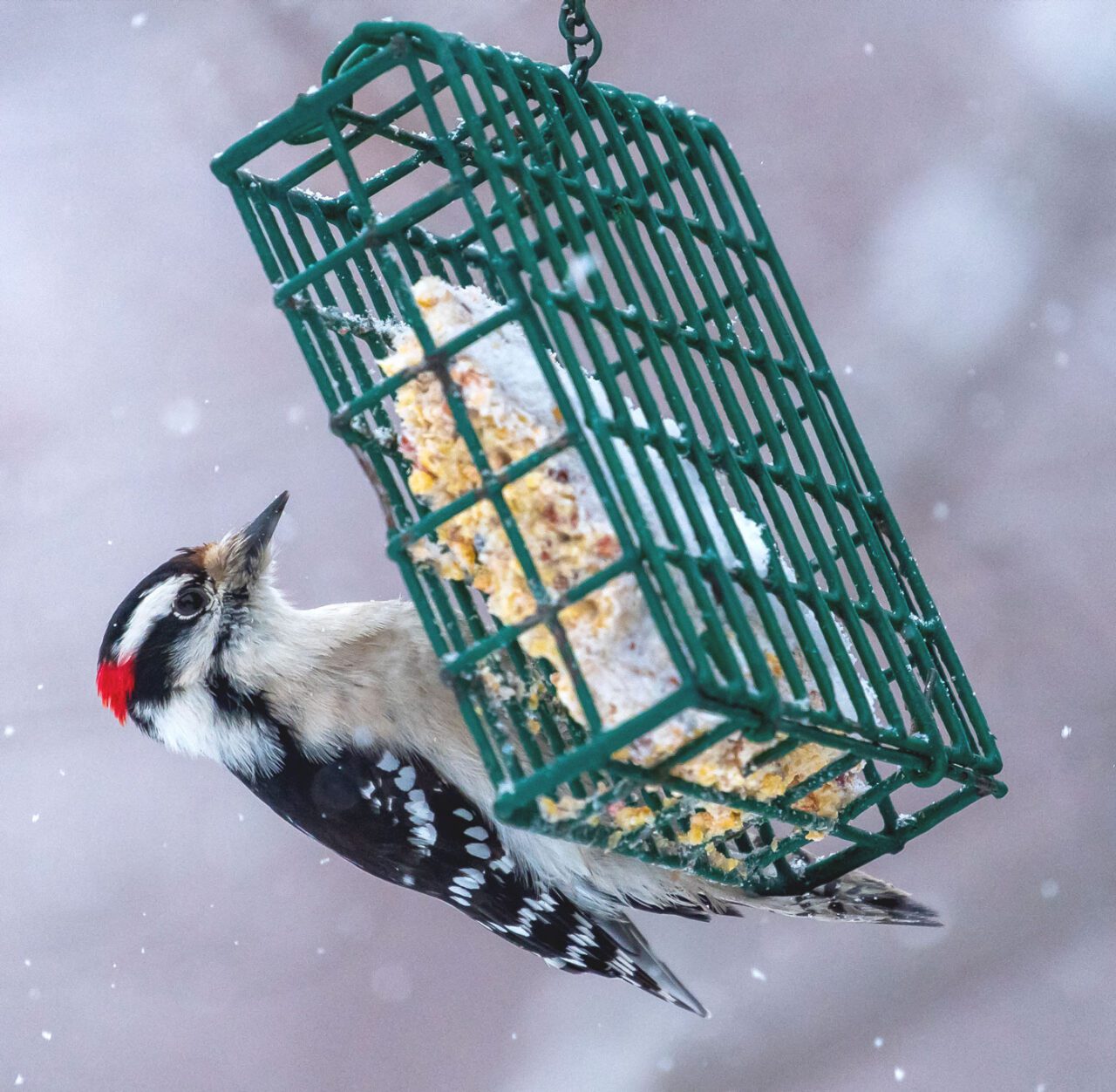

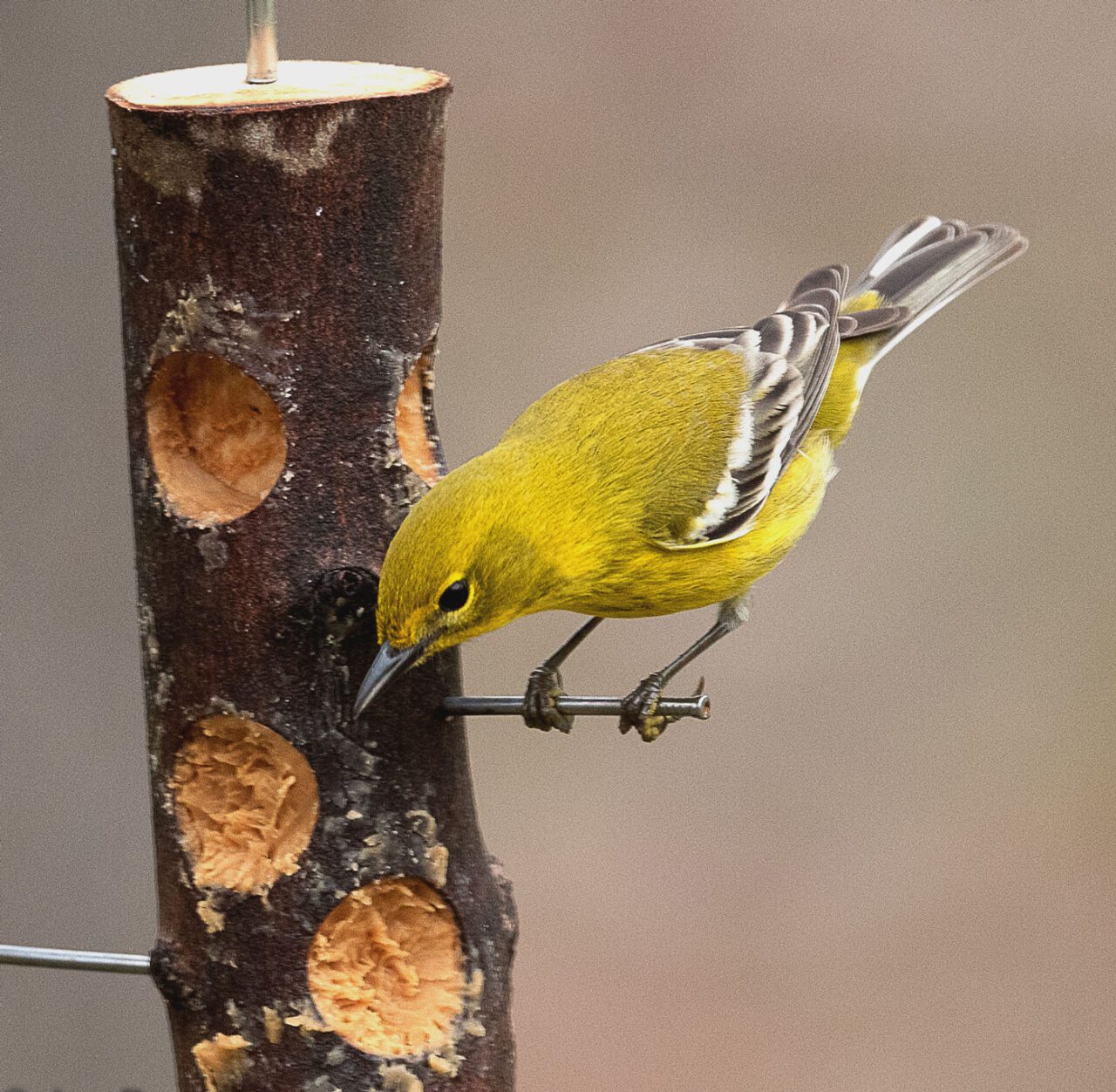

In Brief: Suet feeders are a great way to offer high-energy food to birds, especially woodpeckers, nuthatches, chickadees, titmice, starlings, jays, and sometimes Carolina Wrens and Pine Warblers. They are most often used during the cooler temperatures of winter, though you can find suet formulations that are stable during hotter temperatures. They come in two main designs: a wire cage built to hold blocks of suet; or pieces of wood (or fake wood) in which you can smear suet or peanut butter.
Pros:
- Attracts a different variety of birds to your feeders, and the birds often feed energetically and acrobatically
- Versatile: can be attached to a tree trunk, suspended from a branch, or fixed onto a hopper or platform feeder
Cons:
- Raw suet can quickly become rancid at temperatures above freezing
- Rendered suet, including most suet sold as bird food, stays hard at temperatures up to about 90°F (32°C). At temperatures warmer than this, suet can soften to the point it musses feathers, affecting their function and, in incubating birds, possibly passing a greasy layer on to eggs and endangering their survival. To avoid this, cease offering suet (and peanut butter) during hot months
Tips:
- To limit the number of starlings or jays at your suet feeder, look for a design that faces the suet cake downward. These force birds to hang upside-down while feeding and favor more agile birds such as woodpeckers and nuthatches
- For a fun DIY suet feeder, carefully drill holes in small logs and then spoon in rendered suet or peanut butter. Or try placing suet or peanut butter in bark crevices (during cool months)
Hummingbird Feeders
In Brief: Nectar feeders are a great way to attract these amazing, feathered jewels; you can hang a feeder almost anywhere; and they’re great even if you don’t have a yard. You might even attract other species including orioles or Cape May Warblers.
Pros:
- Easy to set up even with limited outdoor space
- A great way to attract these gorgeous aerial acrobats
Cons:
- High-sugar hummingbird food can quickly spoil, necessitating frequent cleaning
- The sweet nectar can attract ants and wasps
Tips:
- Put up hummingbird feeders early in the season so they can be discovered as migrating birds arrive
- It’s easy to make your own hummingbird food
- There’s no need to use red food coloring
- Planting native plants in a yard or container garden is another great way to attract hummingbirds

